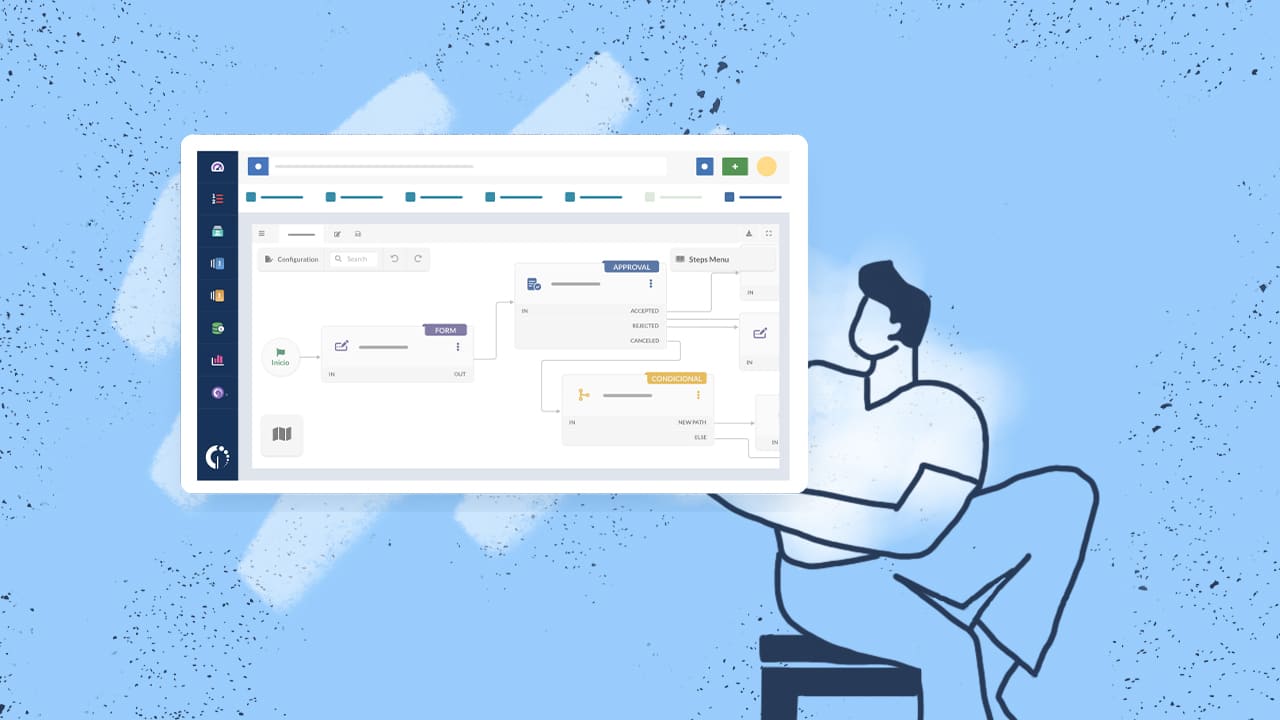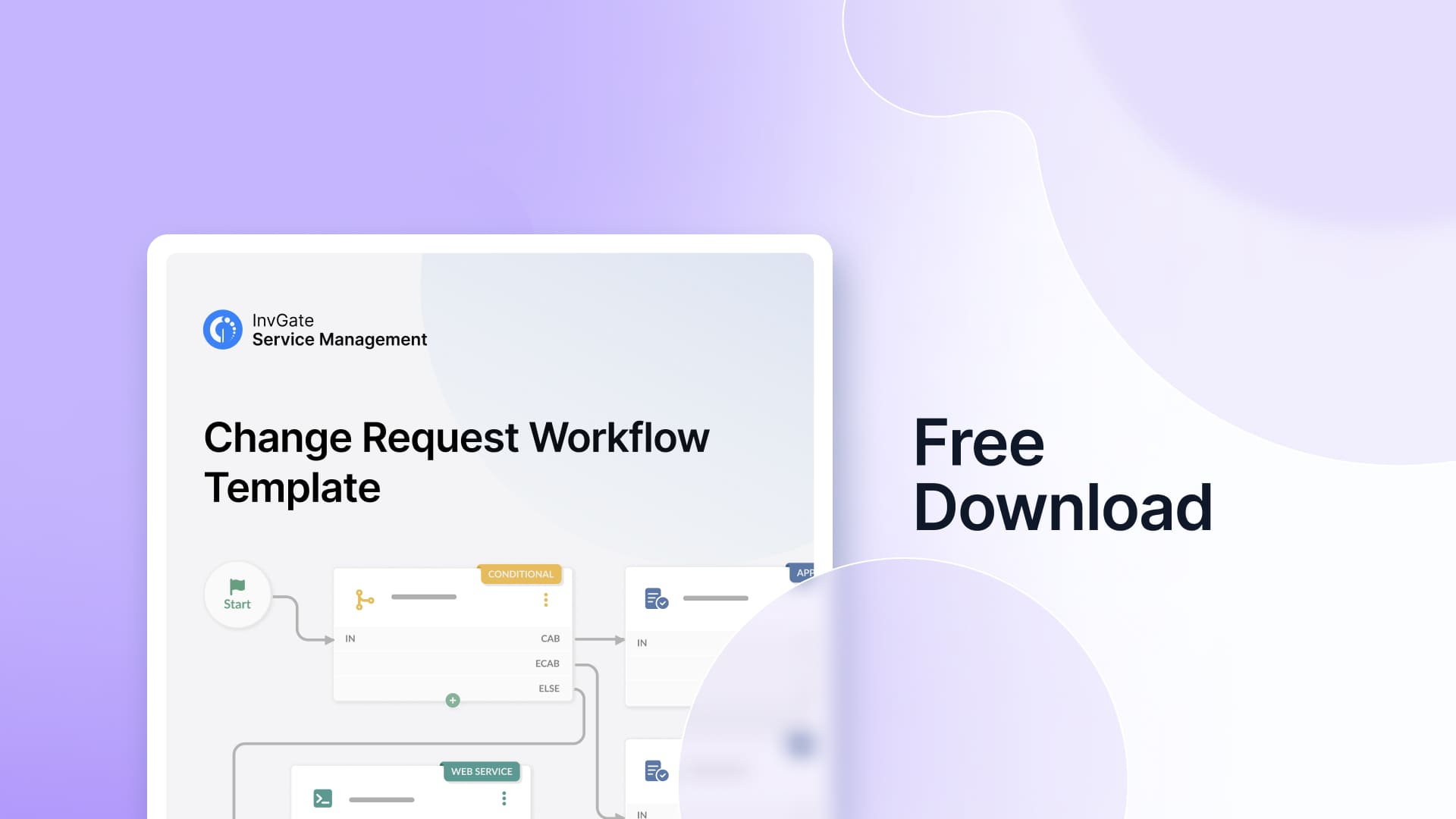Change Management is a critical practice for organizations to effectively adapt, innovate, and maintain stability. It involves various aspects of an organization's IT infrastructure, applications, processes, and policies. As the scope and complexity of changes continue to grow, the need to automate a Change Management workflow becomes paramount.
In this article, we will explore the different types of changes described by ITIL to then break down the process behind automating the Change Management process. Furthermore, we'll explore how to build custom workflows with InvGate Service Management, combining the power of both adaptability and efficiency.
So, without further ado, let’s dive in!

Why do you need to automate the Change Management process?
You are probably already aware that building automated workflows can help you save significant time and reduce errors during the process. And this is also true for Change Management. However, that’s not the main benefit.
By creating workflows specifically designed for this practice (or adapted to another concept of change in other ITSM frameworks, if you prefer) you’re first and foremost designing a Standard Operating Procedure (SOP).
Hence, it will provide you with well-organized and complete documentation to guide your team through a change.

In particular, a Change Management process gives you:
- A reliable record of possible changes along with the necessary steps to carry them out successfully.
- A standardized way to inform employees about planned changes.
- A complete view of the potential ripple effects of any type of change.
- A protocol to execute change in a known, repeatable, and compliant manner.
- A solid position to face audits, avoid outages, and maintain the security and integrity of sensitive systems.
In short, automated workflows are a great ally when it comes to coordinating complex dependencies and redundancies across your organization – which, as a consequence, enhances Enterprise Service Management (ESM).

3 types of changes that can be automated
Now that we've explored the rationale behind automating Change Management workflows, let's delve into the specific types of changes that are prime candidates for automation.
ITIL defines three primary types of change: standard, emergency, and normal. However, although these are a great starting point, remember the best guidelines will always be those that align with your business's unique needs.
Standard Change
A standard change is characterized by its routine nature, requiring minimal oversight and planning. It's frequently executed multiple times a day, hour, or even minute – depending on your organization's size, complexity, and velocity.
It can include pushing code, increasing storage, restarting servers, bouncing services, and resource allocation in non-production environments. Well implemented, these types of changes don’t look so much like changes but more like requests.
Nevertheless, standard changes are key to building scalable, highly available, and resilient services across organizations. For these cases, automation is particularly well-suited, as their repetitive nature can be streamlined through predefined workflows.
Emergency Change
Emergency changes are carried out in response to critical situations where immediate action is required. Approval might take a back seat in these scenarios and the focus is placed on swift resolution. This makes fast collaboration between administrators and other stakeholders crucial.
For instance, in a retail organization, the inability to process credit card transactions is an expensive emergency. The infrastructure team must act swiftly to diagnose and address the issue, while an emergency change record might be created post-facto based on severity and governance requirements.
This is where Change Management serves and is dependent on Incident and Major Incident Management. Mature teams will require a major incident with revenue impact in order to justify an emergency, unauthorized and unplanned change.
Normal Change
While normal changes might seem similar to standard changes, the risk associated with this category is notably higher. They are more complex than routine tasks but don't demand immediate action like emergencies. A glitch during these changes could impact a substantial group of employees or customers, disrupting business operations and causing downtime.
Examples include making significant configuration adjustments to email servers or upgrading software on widely-used servers. This is particularly true in systems where redundancy is impossible or too costly.
Normal Change automation must follow a pattern that can be adapted to many request types. Any change that hasn’t been made before will probably fall into this category. And, once it becomes recurrent, it will probably have its own process under a Standard Change structure.

How to build a Change Management workflow on InvGate Service Management?
InvGate Service Management is an ITSM tool with built-in capabilities to create a custom Change Management workflow tailored to your organization's specific requirements. This is done within the workflow feature that enables you to plan and set out each step of the process.
For the purpose of this guide, we will focus on how to build a Normal Change Workflow. You can use it as a starting point and adapt it to other types of changes if you need to.
Plus, before we start, remember you can download our free change request workflow template to complement the process.
Now, let’s see how it’s done.
1. Start with a trigger
Every workflow process begins by setting a trigger. For this case, you have to choose “Request for Change (RFC),” where you will find a form to fill in the following:
- Categorization of the change - This is where you select “Normal” change.
- Description - A text box for describing the change in plain language for the entire department to understand what is happening.
- CI linking - If your instance is integrated with InvGate Asset Management, you can link the Configuration Item (CI) requiring change integrated with your CMDB.
- Implementation time - The planned date, time, and duration.
- Implementation and rollback plans - A text box that specifies what’s needed for the implementations and, in case it’s needed, the rollback plans.
- The possibility to attach files -This can be required for bigger changes that involve security or architecture review.
2. Send an approval request
Once the workflow is triggered, it is time to send an approval request. To do so, InvGate Service Management allows you to customize:
- Approval types.
- Designated approvers.
- Approver groups - along with rules stating how many people need to respond to approve or reject a change.
- Approval delegation (in case of an absence).
- Expiration date.
You can also set conditions for approvals based on factors like percentage of agreement, first response, and more.
Then, create a two-way path to follow. That is, to close the request if it’s rejected or to continue the work if it’s approved.
3. Communicate the change
As we’ve mentioned before, documentation is central to Change Management. So, the next step is to communicate with the teams and customers who will be impacted by the change.
It can be useful to create a calendar event within your preferred calendar platform (Google, Outlook, etc.) for this stage. This will provide visibility into the forward schedule of changes and the activities planned for each day.
Utilize InvGate Service Management’s API integration to create a web service call, which will populate the calendar entry with pertinent change details.
The same goes for emails or other notifications. Automating them (or at the least assigning it a task) will ensure that the change gets done and that there is enough warning time for people to prepare and be aware.

4. Implementation day
The implementation day is where all comes into action. The more accurately you have completed the previous steps, the better prepared you will be to carry it out successfully.
For implementation, all the information your team needs to make the change happen must be clearly set out and available.
The change plan must include the steps that are needed to implement the change, or at least a general sense of what needs to be done. So, define your required tasks and optional tasks with due dates and assign responsible teams or team members.
You must also be prepared to document the whole process (this is very important for the next step). Once again, these fields will depend on the specific needs of your organization, including compliance and regulations policies.
5. Review stage
Finally, the review stage is about making sure that the change was performed as planned. To build it, InvGate Service Management includes fields for:
- The change's outcome. Was it successful? Did it go as planned? For instance, maybe you had to deviate from the plan, but it was still successful.
- Rollback actions and activities (if any were taken).
- A text box for additional notes.
Again, a two-way path follows this stage. If a rollback is necessary, specific tasks can be outlined. If not, a notification of termination can be sent, leading to end of the workflow.
And you’re done! The Change Management process automation is complete. The only remaining steps in the process are to focus on improvements. Did this change get planned, reviewed and communicated properly and effectively? These reflection points are key in maturing any operation.
In short
Setting out a clear and well-structured Change Management workflow will make sure change is performed in a controlled and efficient manner throughout your organization. It also helps guarantee that all involved parties are aware of the schedule and their responsibilities.
However, it's important to remember that the change process is as diverse as the organizations it operates in. The key lies in tailoring your approach to what works best for your people, services, and products. That’s also why it’s important for your chosen tool to offer customization capabilities when building the workflow.
If you’re ready to see how it’s done, request InvGate Service Management’s 30-day free trial and start customizing your Change Management process!















